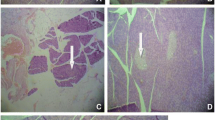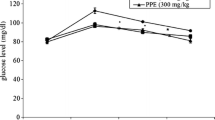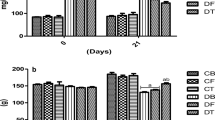Abstract
The present study was aimed to evaluate the antihyperglycaemic and antihyperlipidemic activity potential of Citrus sinensis ethanolic peel extract in normal and streptozotocin (STZ)-induced diabetic rats. The dose-dependent effects of 28-day oral treatment with ethanolic peel extract (250 and 500 mg/kg) from the plant of C. sinensis on blood glucose, glycosylated haemoglobin (HbA1c), plasma insulin, carbohydrate-metabolizing enzymes (hexokinase, glucose-6-phosphatase, glucose-6-phosphate dehydrogenase, glycogen phosphorylase), glycogen levels and lipid levels were determined after oral administration of a dose of C. sinensis (250 and 500 mg/kg body weight) in diabetic groups. A significant decrease in blood glucose, glycosylated haemoglobin and lipid levels was observed in diabetic rats treated with C. sinensis. The activities of carbohydrate-metabolizing enzymes such as hexokinase were significantly increased whereas glucose-6-phosphatase was significantly decreased by the administration of C. sinensis in diabetic rats. A two-fold increase in insulin levels was observed, suggesting that the peel extract has an insulin secretory activity. The findings suggest that C. sinensis peel extract has potent antidiabetic activity in STZ-induced diabetic rats.





Similar content being viewed by others
References
Osmani OH, Sekar DS, Senthil Kumar KL, Sahu RK, Roy A. In vivo antidiabetic potential of Artocarpus heterophyllus plant seeds in streptozotocin-induced-diabetic rats. Biomed Pharmacol J. 2009;2(2):339–43.
Wild S, Roglic G, Green A, Sicree R, King H. Global prevalence of diabetes: estimates for the year 2000 and projections for 2030. Diabetes Care. 2004;27:1047–53.
World Health Organization (WHO). Quality control methods for medicinal plant materials. Geneva. 1998.
Chalova VI, Crandall PG, Ricke SC. Microbial inhibitory and radical scavenging activities of cold-pressed terpeneless Valencia orange (Citrus sinensis) oil in different dispersing agents. J Sci Food Agric. 2010;90(5):870–6.
Pan Z, Liu Q, Yun Z, Guan R, Zeng W, Xu Q, et al. Comparative proteomics of a lycopene-accumulating mutant reveals the important role of oxidative stress on carotenogenesis in sweet orange (Citrus sinensis [L.] osbeck). Proteomics. 2009;9(24):5455–70.
Kanaze FI, Termentzi A, Gabrieli C, Niopas I, Georgarakis M, Kokkalou E. The phytochemical analysis and antioxidant activity assessment of orange peel (Citrus sinensis) cultivated in Greece-Crete indicates a new commercial source of hesperidin. Biomed Chromatogr. 2009;23(3):239–49.
Singh P, Shukla R, Prakash B, Kumar A, Singh S, Mishra PK, et al. Chemical profile, antifungal, antiaflatoxigenic and antioxidant activity of Citrus maxima Burm. and Citrus sinensis (L.) Osbeck essential oils and their cyclic monoterpene, DL-limonene. Food Chem Toxicol. 2010;48(6):1734–40.
Hossain MZ, Shibib BA, Rahman R. Hypoglycemic effects of Coccinia indica inhibition of key gluconeogenic enzyme, glucose-6-phosphatase. Indian J Exp Biol. 1992;10:418–20.
Kokate CK. Practical pharmacognosy. New Delhi: Vallabh Prakashan; 1994. p. 107–13.
Harbourne JB. Phytochemcial methods: a guide to modern techniques of plant analysis. 2nd ed. London: Chapman and Hall; 1984.
Ghosh MN. Toxicity studies. In: Fundamentals of experimental pharmacology. Scientific Book Agency, Calcutta; 1984. p. 153–158.
Turner MA. Screening methods in pharmacology. New York: Academic; 1965. p. 26.
Venkatesh S, Thilagavathy J, Shyam Sundar D. Anti-diabetic activity of flowers of Hibiscus rosasinensis. Fitoterapia. 2008;79:79.
Du Vigneaud V, Karr V. Carbohydrate utilization and disappearance. J Biol Chem. 1985;66:281.
Sasaki T, Matsy S, Sonae A. Effect of acetic acid concentration on the color reaction in the O-toluidine boric acid method for blood glucose estimation. Rinsho Kagaku. 1972;1:346–53.
Anderson L, Dinesen B, Jorgesen PN, Poulsen F, Roder MF. Enzyme immunoassay for intact human insulin in serum or plasma. Clin Chim Acta. 1993;38:578–85.
Brandstrup N, Kirk JE, Bruni C. The hexokinase and phosphoglucoisomerase activities of aortic and pulmonary artery tissue in individuals of various ages. J Gerontol. 1957;12:166–71.
Koida H, Oda T. Pathological occurrence of glucose-6-phosphatase in liver disease. Clin Chim Acta. 1959;74:554–61.
Ellis HA, Kirkman HN. A colorimetric method for assay of erythrocyte glucose-6-phosphate dehydrogenase. Proc Soc Exp Biol Med. 1961;106:607–9.
Shull KH, Ashmore J, Mayer J. Hexokinase, glucose-6-phosphatase and phosphorylase levels in hereditarily obese hyperglycemic mice. Arch Biochem Biophys. 1956;62:210–6.
Morales MA, Jabbagy AJ, Terenzi HF. Mutations affecting accumulation of glycogen. Neurospora News Lett. 1973;20:24–5.
Grover JK, Vats V. Shifting paradigm from conventional to alternate medicine. An introduction on traditional Indian medicine. Asia Pac Biotechnol News. 2001;5:28–32.
Chakravarthy BK, Gupta S, Gambhir SS, Gode KD. Pacreatic beta cell regeneration: a novel antidiabetic mechanism of Petercarpus marsupium. Indian J Pharmacol. 1980;12:123–8.
Shanmugasundaram ERB, Rajeshwari G, Baskaran X, Kumar BRR, Shanmugasundaram KR, Ahmath BK. Use of Gymnema sylvestre leaf extract in the control of blood glucose in insulin dependent diabetes mellitus. J Ethnopharmacol. 1990;30:281–94.
Cakici I, Hurmoglu C, Tunctan B, Abacioglu N, Kanzik I, Sener B. Hypoglycemic effect of Momordica charantia extracts in normoglycemic or cyprohepatidine-induced hyperglycemic mice. J Ethnopharmacol. 1994;44:117–21.
Hassan HA, El-Agmy SM, Gaur RL, Fernando A, Raj MHG, Ouhtit A. In vivo evidence of hepato and reno-protective effects of garlic oil against sodium nitrite-induced oxidative stress. Int J Biol Sci. 2009;5:249–55.
Hikino H, Kobayashi M, Suzuki Y, Konno C. Mechanism of hypoglycemic activity of aconitan SA glycan from Aconitum carmichaeli roots. J Ethnopharmacol. 1987;19:916–23.
Weber G, Lea MA, Fisher EA, Stamm NB. Regulatory pattern of liver carbohydrate metabolizing enzymes: insulin as an inducer of key glycolytic enzymes. Enzymol Clin. 1966;7:11–24.
Fenwic DE, Oakenfull D. Saponin content of soya beans and some commercial soya bean products. J Sci Food Agric. 1980;32:273–8.
Author information
Authors and Affiliations
Corresponding author
Rights and permissions
About this article
Cite this article
Kumar, P.R.Z.A., Bhaskar, A. Evaluation of antihyperglycaemic and antihyperlipidemic activity of Citrus sinensis peel extract on streptozotocin-induced diabetic rats. Int J Diabetes Dev Ctries 35, 448–453 (2015). https://doi.org/10.1007/s13410-015-0310-7
Received:
Accepted:
Published:
Issue Date:
DOI: https://doi.org/10.1007/s13410-015-0310-7




